"There are children learning in classrooms set up in hospitals due to long-term hospitalization. We should provide them with experience that leads to further enhancement of their foundation for living." This thought led to a remote education project that would support hospitalized children, making use of 5G and other advanced technologies. The proposal was made by a designer who had been doing activities to support children with disabilities since his school days. That was a challenge that would lead to the achievement of Goal 4 "Ensure inclusive and equitable quality education for all" of SDGs (Sustainable Development Goals) adopted by the United Nations.
Design of Remote Education by 5G
Experiential Learning by Connecting an Aquarium and an In-hospital Classroom

Publication date: January 4, 2021
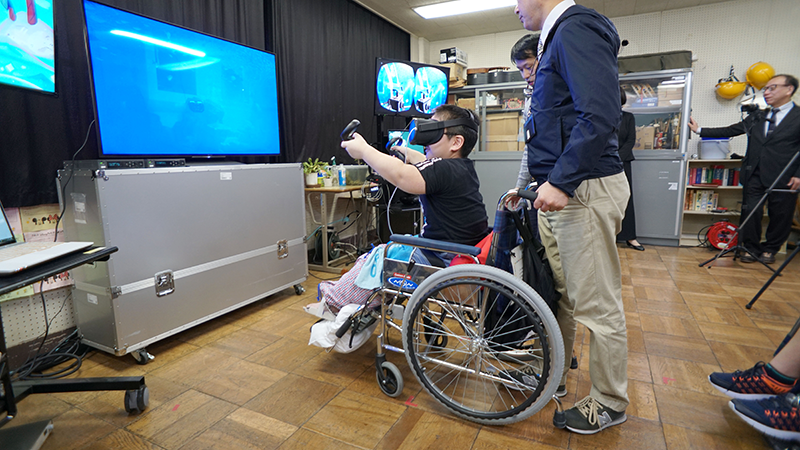
Children's Shouts of Joy in Experiential Learning "Swim With a Shark"
On February 28, 2020, an in-hospital classroom in Tokyo where hospitalized children learn was filled with cheerful voices. A demonstration experiment of remote education (experiential learning) was carried out by connecting the Okinawa Churaumi Aquarium and the classroom by means of technologies, such as 5G video transmission, underwater drone, and VR. Children wearing a head-mounted display enjoyed feeling as if they were swimming about in the aquarium and observed a gigantic whale shark and other fish. Some children were even scared because the experience was so real. They say that children were still excited after returning to their patients' rooms and continued merrily talking about the experience, which made doctors happy, too.
This project has been conducted by Fujitsu since 2019 in cooperation with the Department of Education of Kwansei Gakuin University, NTT docomo, and other organizations. More than 20 children have enjoyed experiences that they cannot have even at ordinary school.
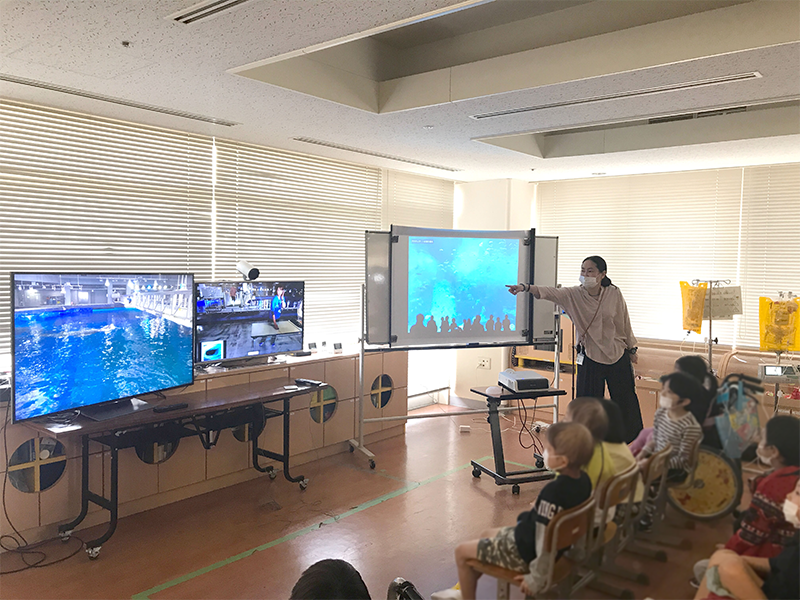
The starting point is the volunteer activities in his school days
This project was proposed by Ken Suginome at the Design Center. Suginome, who said that he would like to work as a bridge between technology and humans when asked about the reason for his application at a job interview for Fujitsu, used to pick up children with disabilities as a volunteer in his school days. One day, he got bit by a child. He was surprised at first, but later heard that it was the child's expression of happiness. He thought, "How wonderful it would be if these children had a means to freely express their emotions." This was the starting point leading to his current job.
With this background, he has worked on many universal design-related jobs since joining Fujitsu, such as the development of applications that assist children with intellectual or developmental disabilities in learning and life. Therefore, this time again, he proposed to use 5G to support children learning in classrooms in hospitals when asked by the sales department to consider a business that makes use of the technology.
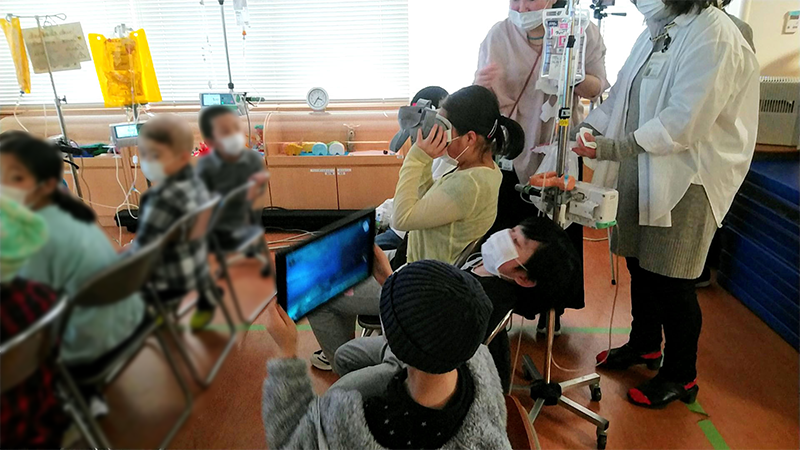
Exploring Children's Needs by Repeatedly Visiting In-hospital Classrooms
What value could be delivered to hospitalized children using 5G? Suginome visited schools for the handicapped and in-hospital classrooms in the metropolitan area and Hiroshima Prefecture to listen to children and people around them. Through the visits, he felt that some children who were hospitalized for a long time had a problem of lacking daily life experience that would be the foundation of learning.
He said, "When an arithmetic problem, for example, "how much change will you get when buying apples" is presented to children who have been hospitalized since infancy and can hardly go out, they cannot imagine shopping. This lack of daily life experience prevents the growth of their understanding in learning. I thought I'd like to provide those children with experience that would be their foundation for living."
Within this context, a venture company with underwater drones and VR technology, which Fujitsu did not have, joined the project and members exchanged ideas. As a result, virtual remote learning was decided to be conducted using 5G so that children who did not know about the ocean could learn about it and its creatures.
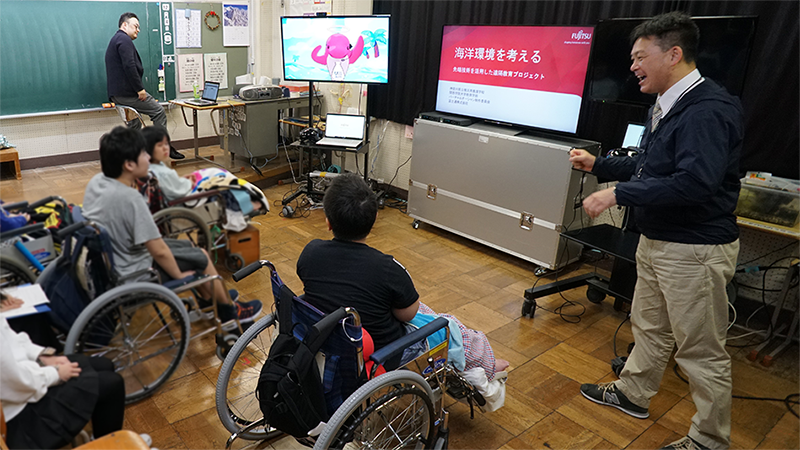
"Relaying Thoughts" from Fujitsu's Tradition
Suginome said that finding partners was important for the realization of the project. To find out what value could be shown using 5G technology, he first envisaged specific value based on advice from experts at universities and the visits to in-hospital classrooms. Then, he looked for a school, aquarium, and internal division or venture company with required technology that could provide cooperation for the realization. As a designer, he set up the framework of the demonstration experiment by connecting the thoughts and technologies of the people involved.
He said, "Teachers at universities are good at showing vision and direction, but may not be so good at depicting concrete ideas, while engineers look for effective use of technologies. I think I, as a designer, was able to work as a bridge between them by depicting scenarios for effective use of technologies toward the realization of the vision based on issues in people's life and society."
He also said that it was significant that there were many predecessors who worked on universal design in Fujitsu.
"Efforts to enable people with disabilities to use personal computers and ATMs have been undertaken internally since 1990's. In recent years, there were predecessors around me who worked on web accessibility or cell phones that would be easy to use for people with disabilities. I recognize myself as having taken over such tradition of Fujitsu and am relaying those thoughts."
Toward Delivery of New Value by Reading Social Needs, Rather Than Based on Technology
The demonstration experiment of the 5G remote education is tentatively ended.
The project received recognition from many directions and won awards at the Kids Design Award 2020, IAUD International Design Award (gold award), and SDGs Partnership Award (special award). It was evaluated from various directions as a very important effort to grow the foundation for living by providing hospitalized children with various types of experiential learning.
Suginome talked about the future development, saying, "I'd like to think about how I can deliver new value to people's lives and society by understanding social needs first, rather than being based on technology." He re-entered university four years ago and was nationally certified as a social worker.
He said, "As a designer and social worker, I think my mission is to create an environment where everyone can comfortably live by making use of technology and clarifying the social structure that causes social welfare issues. I'd like to continue thinking about the delivery of new value, considering whether this framework can also be utilized for issues in the elderly or for solving issues in areas such as isolated islands and remote areas."
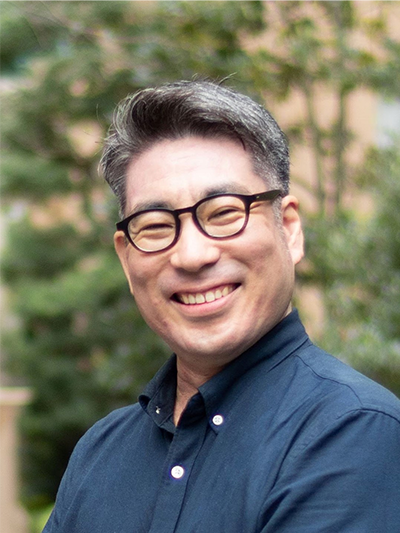 Ken Suginome, Design Center
Ken Suginome, Design CenterRelated Information
- Distance education for the 5G era, connecting aquariums and in-hospital classes, VR and underwater drones for hands-on learning (FUJITSU JOURNAL) (Japanese only) >
- "learn together" for Children in Special Needs Education (FUJITSU JOURNAL) (Japanese only) >
- Kwansei Gakuin University, Fujitsu Conduct Demonstration of Remote Education Using 5G (Press Releases) (Japanese only) >
- Demonstrative Research for Remote Support of Special Needs Education in Remote Islands and Remote Areas (Press Releases) (Japanese only) >
- What we should do to realize a society without disabilities — "Super Welfare Exhibition 2018" From the autism VR experience workshop (External Site: Tomorrow's Community Lab) (Japanese only) >
- SDGs Initiatives >
- Universal Design >
- KIDS DESIGN AWARD 2020 (Awards) (Japanese only) >
- IAUD International Design Award 2020 (Awards) (Japanese only) >
- Japan SDGs Award JAPAN SDGs Action Platform (Awards: Ministry of Foreign Affairs) (Japanese only) >
